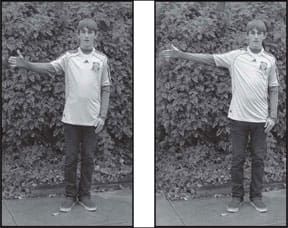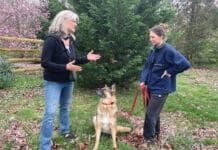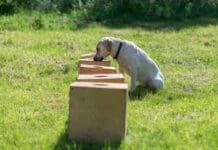[Updated June 29, 2018]
When I was a young girl, my parents dropped me off at the Milwaukee Coliseum every January, on the last day of the big benched dog show. I spent most of the day in the stands overlooking the obedience rings, mesmerized by the magic of well-trained dogs working in close partnership with their humans. I was particularly impressed with the hand signal exercises in the advanced obedience classes. Amazing, I thought, that you can communicate with your dog without even talking!

What I didn’t realize then but I know now, is that hand signals are actually quite simple to teach to dogs – much easier than getting behavior on verbal cue. And hand signals can be used in many situations where a verbal cue just won’t work.
Dogs Are Good At Reading Body Language
The general dog-owning population today is much more aware of the fact that dogs are, first and foremost, body language communicators, thanks to the work of people like Patricia McConnell, Ph.D., and Turid Rugaas. Dogs need to make sense of our movements in order to survive. They depend on reading us to make their world work for them. As Dr. McConnell writes in The Other End of the Leash, “All dogs are brilliant at perceiving the slightest movement that we make, and they assume that each tiny movement has meaning.”
This makes teaching hand signals incredibly easy. Our dogs already assume our movements have meaning; we just have to make sure they’re attaching the meaning we want them to have for our particular signals. You’ll realize how truly brilliant your dog is when you see how quickly she comes to understand the meaning – and offer the requested behavior – for your body language cues for sit, down, come, and anything else you want to put on a nonverbal cue.
In fact, many dog folks think their dogs have learned verbal cues, only to find out that their dogs are actually keying off non-verbal communications the owner doesn’t even realize she’s making, such as a tiny bend forward at the waist with the “down” cue, or a slight movement of the hand toward the chest that accompanies the word “sit.” Owners do these things so consistently that they become an important part of the picture for the dog, and the human doesn’t realize that the verbal cue is actually secondary. This is bad news for putting behaviors completely on verbal cue, but good news for putting behaviors on a hand signal cue.

This is the gesture I use for cuing “Down!” It’s a large signal that can be seen by a dog who is far away.
Advantages of Training Dogs with Hand Signals
There are several advantages to teaching hand signals, even if you have no intention of competing in the obedience ring:
• They’re easy to teach.
• You can use them when you don’t want to speak – to avoid waking a sleeping baby, when you’re having a conversation on the phone, when you have laryngitis.
• They come in handy when your senior dog begins losing her hearing.
• They are the only way to train a hearing-impaired dog.
• They are useful if you have dreams of doing TV or movie work with your dog.
• It’s gratifying to show off to your friends how well your dog responds to the silent signals.
How to Teach Your Dog Hand Signals
So, how do you deliberately teach a hand signal? Here’s how I do it:
1. Start with a behavior you’re already taught your dog perform on verbal cue, such as “down.”
2. With your dog sitting in front of you, fully extend your right hand straight up in the air and hold it there. Hold a small treat between your thumb and the palm of your hand.
3. Pause for two seconds, then say “Down!”
4. If he lies down, click (or use another reward marker, such as the word “Yes!”) and give him a treat. And praise him!
If he doesn’t lie down, use the treat in your hand to lure him down, then click and treat. Even though he “knows” the verbal cue, chances are your hand raised in the air (different body language!) will throw him off his game at first and he won’t respond to it. “Down!” with your arms at your sides is different from “down” with one hand raised in the air.
5. Repeat until your dog lies down when you raise your hand. You might sometimes wait a few seconds longer before you say “down” or use a lure, to see if his brain just needs a bit more time to process the information.
6. Repeat until he lies down consistently (at least 8 out of 10 times) when you raise your hand, without having to use your verbal cure or lure.
7. Celebrate!
Use Big Gestures as Dog Training Cues
It’s as simple as that. Dogs can learn several cues for one behavior; they just can’t learn several behaviors for the same cue. Anytime you’re teaching a new cue for an already-trained behavior, use the new cue first, followed by the old one. It’s as if you’re saying, “Dog, this cue (hand raised high in the air) means the same thing as this other cue (the word “down”).” Your dog will quickly figure out that the new cue is always followed by the one he knows, and he’ll anticipate the second cue, offering the behavior sooner in order to get his click and treat faster.
Dogs are really good at anticipating. Remember that figuring us out is how they make our world work for them. As soon as your dog realizes the new cue is always followed by the old cue, he’ll jump the gun – which is exactly what you want. Why wait around for the second cue? He knows what he has to do to make you click the clicker and earn the treat.
Often in class when I introduce the raised-hand signal for down, a student will say, “But my dog already knows a signal for down.” She points to the ground, and sure enough, her dog promptly drops to the ground at her feet.
“That’s great!” I say. “And here’s the deal. Pointing to the floor works perfectly when your dog is right in front of you. But if he’s on the opposite side of the room – or a field, or, heaven forbid, a busy road, he may not be able to see that small signal. If he’s mildly distracted, a small signal will escape his notice, while a big one might grab his attention. A large signal that’s silhouetted against the background is easier for your dog to see, and more likely to work for you in all conditions.”
So use big movements for all your basic hand signals. You want your dog to have the best chance of seeing them from afar, even with distractions. Of course you can still use the smaller signal when he’s close if you want; dogs can learn many cues for one behavior.

Teaching “Sit” with Hand Signals
Here’s another useful hand signal: Sit. You can use the same signal to ask your dog to sit either from a stand or a down position. You can use any big gesture that makes sense to you. The gesture I use for cuing “Sit” is an upward sweeping motion with my left hand, bringing it up the left side of my chest, and then out to the side with a flourish, as if I was saying, “Ta da!”
When asking a dog to sit from a down position, make the new gesture, then pause with your arm parallel to the ground (tasty treat hidden under your thumb), and then say “Sit!” If he doesn’t respond to the verbal cue, lower your left hand with the treat and lure him up into the sit. Click and treat. Repeat until he sits for the signal, without the verbal cue or lure. It helps to pause after the first signal to give him time to think!
When he’ll sit for the hand signal from the down position, do the same thing from the stand. Start with him standing, facing you. Make the sweeping “ta da” flourish with your left hand, pause with your arm parallel to the ground and, if necessary, prompt with the verbal cue, then the lure. When he sits, click and treat.
“Come” is even easier. Leave your dog on a “Wait” cue, or have someone hold him on leash. Back up until you’re about 10 feet away and stand still. When your dog is looking at you, bring your right hand up to your chest, and then swing it away from you in an arc parallel to the ground, as if you want to thump someone in the stomach who is standing off to your side and slightly behind you. When your arm is stretched straight out, parallel to the ground, pause for two seconds, then say “Come!” in a cheery tone of voice and run backward a couple of steps.
As your dog runs toward you, click, bring your hand back to your chest (so your dog comes to your center instead of your side), and when he gets to you, feed him the treat you had hidden under your thumb. Or better yet, wait for his automatic default sit and then feed him the treat. Note: If your dog doesn’t yet offer an automatic sit, work on that separately and treat him just for coming.

The Subtle Signals You Give While Training
There are times when subtle signals might be more useful than big ones – and they don’t have to be hand signals. Musical freestyle for dogs (also known as “dancing with your dog”) incorporates subtle signals designed to look like dance moves, as well as big signals that are dance moves. Well-trained agility and rally dogs can key off slight changes in their handlers’ body positions; the smart handler purposefully trains and makes use of this ability. If you’re working on a trick routine with your dog, subtle signals might be just the ticket. A friend of mine can ask her Jack Russell Terrier to lie flat on one side or the other just by tipping her head to one side or the other.
The process is the same whether you use big signals or small ones. Decide what non-verbal communication you want to use; figure out how to get your dog to do the behavior; then give the signal followed by a pause, and whatever prompt is needed to get him to do it. Repeat until he performs the behavior on just the body language cue.
I haven’t been to a big benched show in decades, and the dog training and showing world has changed a lot. But some things don’t change. I’m still enthralled by the magic of well-trained dogs working in close partnership with their humans.
Pat Miller, CBCC-KA, CPDT-KA, is Whole Dog Journal‘s Training Editor. Miller lives in Hagerstown, Maryland, site of her Peaceable Paws training center. Pat is also author of The Power of Positive Dog Training; Positive Perspectives: Love Your Dog, Train Your Dog; Positive Perspectives II: Know Your Dog, Train Your Dog; and Play with Your Dog.






